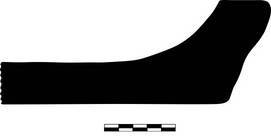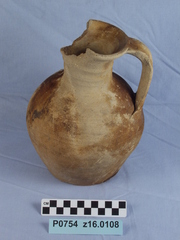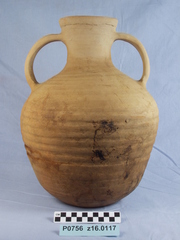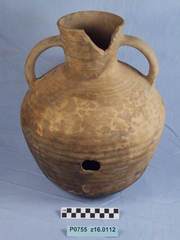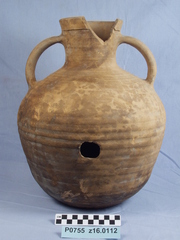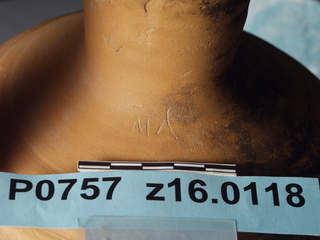Greek, Roman and Byzantine Pottery at Ilion (Troia):
Sebastian Heath and Billur Tekkök, Editors
Roman Plain and/or Partially Slipped Vessels
Please note that this is a public draft of work in progress
The following catalog lists a small selection of plain and partially slipped vessels, mainly utilitarian in form. It is likely that many such vessels are of local or regional manufacture. The large "Portable Processing Platform" (K/L16/17.0114:5) and "Very Large Mixing Bowl/Mortarium" (K/L16/17.0144:5) are exceptional pieces associated with the second century oven in K/L16/17. Their fabric shares large golden mica flakes so that they may be from the same source, perhaps near Phokaia.
1. One Handled Jug (Third Century AD)
H. .228.
z16.0115. P0754. Jug with trefoil rim, missing part of the rim. Flat based? with strap handles. Highly micaceous gritty fabric in orangish buff color (betw 7.5YR 7/4 and 7/6) block volcanic bits on the surface. Found in the z16 shaft deposit.
2. Storage Jar (Third Century AD)
H. .50.
z16.0115. P0756. Nearly complete, two handles, molded base. Orangish buff (between 5YR 6/4 and 6/6) with lime and silver mica. Wheel ridges on body.
3. Jug, local (Third Century AD)
P. H. .25. Est. diam. base .106. Th. .0047.
z16.0115. P0757. Complete except for rim, strap handle, flat base. Reddish (5YR 4/6 and 5/6) fabri with fine silver mica and lime bits visible on the surface. Graffito (inscribed) on shoulder MA. Found in the z16 shaft deposit. Organic deposits on interior and exterior.
4. Semi-slipped bowl (Hadrianic?)
P. H. .07. Est. diam. rim .168. Est. diam. base .064.
. P0455. Almost complete, ten joining fragments. Plain bowl with ring base. Fabric soft buff (between 10YR 6/4 and 7/4), and with a greenish tinge. Some mended fragments have been burned.
First published as no. 58.
svg/P0455.jpg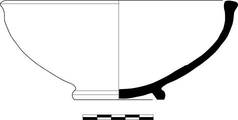
5. Plain Ware Bowl (2nd Century AD)
P. H. .13. Est. diam. rim .30.
K/L16/17.0086:3. Ten joining and non-joining sherds allow profile to be restored. Soft, slightly granular pale green (5Y 8/3) fabric with added sand (quartz, red, black – all small) and frequent lime chunks also visible on surface. The surface may have been intentionally coated dark greenish/gray (near 5Y 3/2) but is only poorly preserved now. The base is irregularly formed with the differing widths shown in the illustration. Metal adheres to sherds K/L16/17:0146:03 and K/L16/17.0118:21a and b.
svg/K-L16-17.0146-3.jpg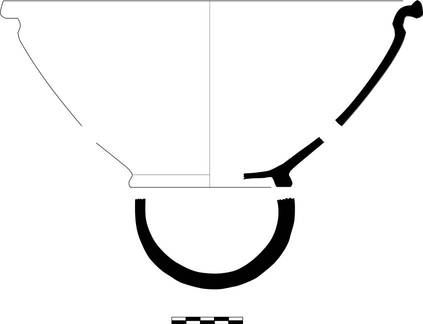
6. Unclassified Plain Ware Cookpot, Downturned Rim
P. H. .057. Est. diam. rim .19 (completely preserved). Th. .004.
K/L16/17.0114:1. Seven joining sherds. Slighty granular brown (5YR 6/6) fabric with frequent varied angular inclusions and gold mica visible in section and on the surface. Thinly coated surface is pale brown (5YR 7/6). One strap handle (as shown by complete preservation of rim). No joins to the simiar vessel in K/L16/17.0112.
svg/K-L16-17.0114-1.jpg
7. Large Portable Processing Platform (2nd Century AD)
P. H. .083. Th. .018. L. 23. W. .132.
K/L16/17.0114:5. Two joining sherds preserve corner, original dimensions not recoverable. The fabric and surface of this piece are identical to the very large mixing bowl/mortarium (K/L16/17.0144:5). The large golden mica flakes, in particular, make it very likely that they come from closely related workshops. There is a layer of white accretion not removed by the acid bath used to conserve the piece but this is not part of the original surface. It is, however, under the remaining patches of dark gray ash so that this is evidence of post-depositional burning: i.e., a sequence of deposition, accretion, burning. Even without knowing the original dimensions, the surviving portion indicates a large and sturdy piece of kitchen equipment. In form, it is a platform with upturned edges. It stood on at least two raised feet, only one of which is in evidence, that ran along parallel sides. The extant foot is .04 high from base to lower floor. There is a single ridge on the sloping upper face of the edge. There is no extant iron adhering to this piece.
svg/K-L16-17.0114-5.jpg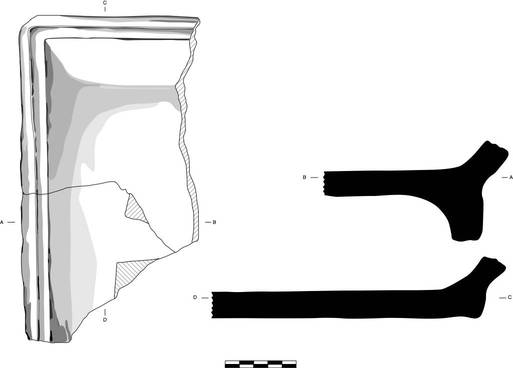
8. Very Large Mixing Bowl/Mortarium (2nd Century AD)
P. H. .078. Est. diam. rim .65-.75. Th. .0295.
K/L16/17.0144:5. Single rim fragment. Fabric is predominantly pale red (5YR 6/6), with variation around this. As with any such large utilitarian vessel, the inclusions in this piece are extremely varied. At the large end is angular quartz up to .007 in length, and rounded lime chunks .002 in diameter. There are gray and reddish stones .005 and smaller. An important component is the regular presence of large and small golden mica flakes, up to .003 in diameter when flattened on the base. At the small end of the size scale are an abundance of angular and rounded light and dark bits. Despite the high frequency of inclusions the paste is not overwhelmed. Using the munsell “charts for estimating the proportions of mottles and coarse inclusions” puts the inclusions in this vessel at between 5 and 7 percent. The coating is pale brown (7.5YR 7/4); it is worn away by use below rim. There is a single patch of iron on the extant interior face.
svg/K-L16-17.0144-5.jpg